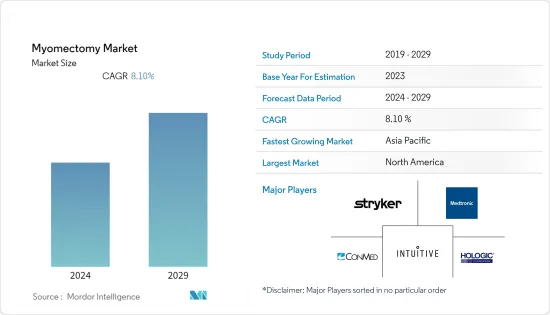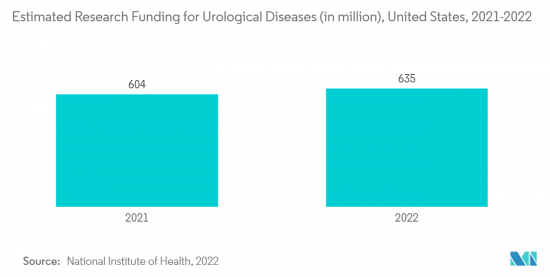
|
시장보고서
상품코드
1406569
자궁근종절제술 - 시장 점유율 분석, 산업 동향 및 통계, 성장 예측(2024-2029년)Myomectomy - Market Share Analysis, Industry Trends & Statistics, Growth Forecasts 2024 - 2029 |
||||||
자궁근종절제술 시장은 2024년 6억 4,000만 달러에서 2029년 9억 3,000만 달러로 성장할 것으로 예상되며, 예측 기간(2024-2029년) 동안 8.1%의 CAGR을 기록할 것으로 예상됩니다.
COVID-19가 자궁근종절제술 시장에 미친 영향은 매우 큽니다. 전 세계적으로 COVID-19 환자가 급증함에 따라 의료 서비스는 COVID-19로 고통받는 환자들에게 자원을 투입했습니다. 팬데믹 기간 동안 환자 관리를 위한 지침과 권고사항이 제공되었습니다. 그 결과 병원은 응급처치를 우선시하고 자궁근종절제술과 같은 선택적 치료를 지연시키거나 연기하여 수개월 동안 수술을 기다리는 환자들의 체류가 발생했습니다. 예를 들어, 2021년 2월 란셋 류마톨로지(Lancet Rheumatology)가 발표한 논문에 따르면, COVID-19 초기에는 많은 국가들이 COVID-19 환자 치료에 인력과 자원을 투입하기 위해 긴급하지 않은 수술을 모두 취소하는 결정을 내렸고, 선택적 수술의 대기 시간 연장은 팬데믹 기간 동안 의료 시스템이 직면한 큰 문제 중 하나였습니다. 그러나 전염병 상황이 정상으로 돌아옴에 따라 자궁근종절제술은 점차 회복될 것으로 예상되며, 본 연구의 예측 기간 동안 시장은 안정적인 성장을 보일 것으로 예상됩니다.

자궁근종 환자 수의 증가는 자궁근종절제술 시장 성장에 기여하는 주요 요인이 될 것으로 예상되며, 2022년 7월 International Journal of Reproduction, Contraception, Obstetrics, and Gynecology에 게재된 기사에 따르면, 자궁근종 발생률이 31-40세에서 약 34.9%로 가장 높은 것으로 나타났다는 연구 결과가 인도에서 발표됐습니다. 자궁근종에서 가장 흔하게 관찰되는 증상은 복부 덩어리(41%)와 비정상적인 자궁 출혈(24.1%)이었습니다. 점막하 근종의 유병률은 38.6%, 경막내 근종 19.3%, 점막하 폴립 14.5%, 자궁근종 13.9%, 장막하 근종 10.2%로 나타났습니다. 또한, 합병증 감소와 입원기간 단축으로 인한 최소침습수술의 증가가 시장 성장에 기여할 것으로 예상됩니다. 또한, 로봇 수술 및 복강경 보조 수술의 증가와 같은 기술 발전은 고품질의 효율적인 치료를 제공하기 위해 자궁근종절제술 시장의 성장에 기여할 수 있습니다.
2021년 12월 MIS 저널이 발표한 기사에 따르면 자궁근종은 일반적인 자궁의 양성 평활근 종양으로 폐경 전 여성의 거의 70%가 앓고 있는 것으로 알려져 있습니다. 자궁근종의 위험인자로는 인종, 분만 횟수, 조기 초경, 늦은 폐경, 가족력, 비만, 고혈압 등이 있습니다. 자궁근종이 있어도 생명을 위협하는 경우는 거의 없습니다. 하지만 비정상적인 출혈, 골반통, 요로장애 등 삶의 질에 영향을 미치는 증상을 동반하는 경우가 많습니다. 로봇 자궁근종절제술은 개복수술에 비해 출혈량이 적고, 합병증이 적으며, 입원 기간이 짧은 등 많은 장점이 있다고 기사는 밝혔습니다. 또한 손목으로 조작하는 기구, 3차원적 시야, 올바른 수술 기법을 도입하는 이점도 대규모의 많은 사례에서 로봇 보조 접근법의 장점을 강조합니다. 이처럼 자궁근종의 부담이 크고 기술적으로 진보된 자궁근종절제술의 이점이 증가함에 따라 시장 성장에 힘을 실어줄 것으로 예상됩니다.
따라서 자궁근종 유병률의 증가와 기술적으로 진보된 자궁근종절제술의 장점 증가와 같은 위의 요인들은 시장 성장을 촉진할 것으로 예상됩니다. 그러나 새로운 의료기기의 높은 비용과 수술에 따른 합병증은 조사 대상 시장의 성장을 제한할 수 있습니다.
자궁근종절제술 시장 동향
예측 기간 동안 복강경 부문이 큰 시장 점유율을 차지할 것으로 예상
복강경 자궁근종절제술은 외과의사가 배꼽 또는 배꼽 근처를 작게 절개하는 수술법입니다. 그런 다음 복강경을 삽입합니다. 복강경이란 카메라가 달린 가는 관을 말합니다. 복강경 자궁근종절제술은 출혈량이 적고, 입원 기간이 짧고, 회복이 빠르며, 수술 후 합병증과 유착 형성률이 낮다는 장점이 있습니다. 이처럼 복강경 자궁근종절제술의 장점이 증가함에 따라 이 분야의 성장을 촉진할 것으로 예상됩니다. 또한, 자궁근종의 유병률 증가와 복강경 자궁근종절제술의 기술 발전이 증가함에 따라 이 부문의 성장을 촉진할 것으로 예상됩니다.
PubMed Central이 2022년 9월에 발표한 논문에 따르면 복강경 자궁근종절제술은 자궁근종절제술의 일반적인 수술법 중 하나입니다. 또한 복강경 자궁근종절제술은 종합적인 재활 간호와 결합하여 자궁근종 환자의 수술 후 스트레스 상태를 효과적으로 감소시키고, 환자의 만족도를 향상시키고, 유해한 감정을 감소시키고, 재활을 촉진할 것으로 나타났다는 연구 결과도 발표되었습니다. 이처럼 복강경 자궁근종절제술의 장점의 증가는 이 분야의 성장을 촉진하는 주요 요인이 되고 있습니다.
또한, 자궁근종 유병률의 증가는 시장 성장을 촉진하는 주요 요인입니다. 예를 들어, 영국 NHS가 2022년 9월에 업데이트한 데이터에 따르면, 자궁근종은 흔한 질환으로 여성 3명 중 2명이 일생 중 한 번 이상 자궁근종을 앓고 있으며, 30-50세 여성에게 가장 많이 발생합니다. 이러한 자궁근종의 높은 유병률은 본 연구의 예측 기간 동안 복강경 자궁근종절제술의 채택을 촉진할 것으로 예상됩니다. 또한, 비뇨기과 질환에 대한 조사의 증가는 예측 기간 동안 부문 성장을 촉진할 것으로 예상됩니다.
따라서 복강경 자궁근종절제술의 장점 증가, 비뇨기과 질환에 대한 연구 증가, 자궁근종 유병률 증가와 같은 위에서 언급한 요인들은 예측 기간 동안 부문 성장을 증가시킬 것으로 예상됩니다.

예측 기간 동안 북미 지역이 자궁근종절제술 시장에서 큰 비중을 차지할 것으로 예상
북미 지역은 자궁근종 유병률 증가와 근종 절제술의 기술 발전으로 인해 예측 기간 동안 근종 절제술 시장에서 큰 점유율을 차지할 것으로 예상됩니다.
미국 여성보건국이 2021년 2월에 발표한 자료에 따르면, 여성의 약 20-80%가 50세 이전에 자궁근종을 앓고 있는 것으로 추정됩니다. 자궁근종은 40-50대 초반 여성에게 많이 발생하며, 자궁근종이 있는 모든 여성에게 증상이 있는 것은 아니지만, 증상이 있는 여성은 자궁근종으로 인해 생활이 어렵다고 느끼는 경우가 많습니다. 이처럼 미국에서는 자궁근종에 대한 부담이 크기 때문에 시장 성장이 기대되고 있습니다.
또한 2022년 12월 Taylor &Francis Online이 발표한 기사에 따르면, 자궁근종(UF)은 자궁의 비암성 증식으로 미국 내 2,600만 명 이상의 여성의 삶에 영향을 미친다고 합니다. 자궁근종은 증상을 동반하지 않을 수도 있지만, 일부 여성은 자궁근종의 존재로 인해 수술적 치료를 받아야 합니다. 따라서 자궁근종의 높은 유병률은 시장 성장을 촉진할 것으로 예상됩니다.
따라서 자궁근종 유병률 증가와 같은 위의 요인들은 예측 기간 동안 이 지역의 시장 성장을 촉진할 것으로 예상됩니다.
자궁근종절제술 산업 개요
자궁근종절제술 시장은 여전히 경쟁이 치열하고 대기업이 시장을 독점하고 있습니다. 기술 발전과 제품 혁신은 시장에서 경쟁하는 기업들에게 새로운 기회를 제공할 것으로 보입니다. 복강경 및 로봇 보조 자궁근종절제술은 기존 방법보다 우수하기 때문에 시장 성장을 촉진할 수 있습니다. 주요 기업으로는 Medtronic PLC, Stryker Corporation, ConMed Corporation, INSIGHTEC Ltd, CooperSurgical Inc., Hologic Inc., KARL STORZ SE & Co. KG, B Braun, Richard Wolf Medical Instruments, and Minerva Surgical Inc. 등이 있습니다.
기타 혜택:
- 엑셀 형식의 시장 예측(ME) 시트
- 3개월간의 애널리스트 지원
목차
제1장 서론
- 조사 가정과 시장 정의
- 조사 범위
제2장 조사 방법
제3장 주요 요약
제4장 시장 역학
- 시장 개요
- 시장 성장 촉진요인
- 자궁근종에 시달리는 환자수 증가
- 최소침습 수술 증가
- 기술 진보
- 시장 성장 억제요인
- 의료기기의 고비용
- 수술에 따른 합병증
- Porter's Five Forces 분석
- 구매자/소비자의 협상력
- 공급 기업의 교섭력
- 신규 참여업체의 위협
- 대체품의 위협
- 경쟁 기업 간의 경쟁 강도
제5장 시장 세분화
- 유형별
- 복부
- 복강경
- 자궁경하
- 로봇
- 제품별
- 복강경 동력 세절기
- 하모닉 메스
- 복강경 실러
- 기타 제품
- 최종사용자별
- 클리닉/병원
- 외래 수술 센터
- 지역별
- 북미
- 미국
- 캐나다
- 멕시코
- 유럽
- 독일
- 영국
- 프랑스
- 이탈리아
- 스페인
- 기타 유럽
- 아시아태평양
- 중국
- 일본
- 인도
- 호주
- 한국
- 기타 아시아태평양
- 세계 기타 지역
- 북미
제6장 경쟁 상황
- 기업 개요
- Medtronic PLC
- Stryker Corporation
- ConMed Corporation
- INSIGHTEC Ltd
- CooperSurgical Inc.
- Hologic Inc.
- Intuitive Surgical Inc.
- KARL STORZ SE & Co. KG
- B Braun SE
- Richard Wolf Medical Instruments
- Minerva Surgical Inc.
제7장 시장 기회와 향후 동향
ksm 24.02.02
The myomectomy market is expected to grow from USD 0.64 billion in 2024 to USD 0.93 billion by 2029, registering a CAGR of 8.1% over the forecast period (2024-2029).
The impact of the COVID-19 pandemic was significant on the myomectomy market. With the surge of COVID-19 cases worldwide, healthcare services diverted their resources toward patients suffering from COVID-19. Guidelines and recommendations were provided for the management of patients during the pandemic. This resulted in hospitals prioritizing emergency procedures and delaying or postponing elective procedures, such as myomectomy surgery, leading to a backlog of patients waiting for their surgeries for months. For instance, according to an article published by the Lancet Rheumatology in February 2021, during the initial pandemic, many countries made the necessary decision to cancel all non-emergency surgical procedures to free up personnel and resources to care for patients with COVID-19 and extended wait times for elective surgeries was but one of the big problems that healthcare systems faced during the pandemic. However, as the pandemic conditions have returned to normal, myomectomy procedures are expected to recover gradually, and the market is expected to have stable growth during the forecast period of the study.
An increase in the number of patients suffering from uterine fibroids is anticipated to be the key factor contributing to the growth of the myomectomy market. According to an article published by the International Journal of Reproduction, Contraception, Obstetrics, and Gynecology in July 2022, a study was conducted in India which showed that the incidence of fibroids is most common in 31-40 years of age, which is around 34.9%. The most commonly observed symptom for uterine fibroids was abdominal lump (41%) and abnormal uterine bleeding (24.1%). The prevalence of submucosal fibroids was 38.6%, intramural fibroids 19.3%, submucosal polyp 14.5%, seedling fibroid 13.9%, and subserosal fibroid 10.2%. Additionally, a rise in minimally invasive surgical procedures due to fewer complications and reduced hospital stays is anticipated to grow the market. Technological advancements, such as the rise in robotic and laparoscopic-assisted surgeries to deliver quality and efficient treatment, may also contribute to the growth of the myomectomy market.
According to an article published by MIS Journal in December 2021, uterine fibroids are considered a common benign smooth muscle tumor of the uterus that affects almost 70% of women until menopause. Risk factors of uterine fibroids include ethnicity, parity, early menarche, late menopause, family history, obesity, and hypertension. The presence of uterine fibroids is rarely life-threatening. Still, they are often associated with symptoms affecting the quality of life, such as abnormal bleeding, pelvic pain, and urinary tract problems. The article also stated that robotic myomectomy has many advantages in uterine fibroid removal, such as lower blood loss, fewer complications, and shorter hospital stays over open surgery. The advantages of the wristed instruments, three-dimensional vision, and the incorporation of correct surgical techniques also emphasize the benefits of the robotic-assisted approach in large and numerous cases. Thus, the high burden of uterine fibroids and the increasing advantages of technologically advanced myomectomy procedures are also expected to boost market growth.
Hence, the factors above, such as the rising prevalence of uterine fibroids and the increasing advantages of technologically advanced myomectomy procedures, are expected to boost the market growth. However, the higher costs of new medical devices and complications associated with the procedure might restrict the growth of the studied market.
Myomectomy Market Trends
Laparoscopic Segment is Expected to Hold a Significant Market Share over the Forecast Period
Laparoscopic myomectomy is a surgical procedure where the surgeon makes a small incision in or near the belly button. Then a laparoscope is inserted, a narrow tube fitted with a camera into the abdomen. Laparoscopic myomectomy has several advantages such as less blood loss, shorter hospital stays, faster recovery, and lower complications and adhesion formation rates after surgery. Thus, the increasing advantages of laparoscopic myomectomy are expected to boost segment growth. Moreover, the increasing prevalence of uterine fibroids and the rising technological advancements in the laparoscopic myomectomy procedure are also expected to boost segment growth.
According to an article published by PubMed Central in September 2022, laparoscopic myomectomy is one of the common procedures for uterine fibroids removal. Also, the article stated that a study showed that laparoscopic myomectomy combined with comprehensive rehabilitation nursing effectively reduced the postoperative stress state of patients with uterine fibroids, improved patient satisfaction, reduced adverse emotions, and promoted rehabilitation. Thus, the increasing advantages of laparoscopic myomectomy are a major factor driving the segment growth.
Furthermore, the rising prevalence of uterine fibroids is a major factor driving the market's growth. For instance, according to the data updated by the United Kingdom NHS in September 2022, uterine fibroids were common, with around 2 in 3 women developing at least 1 fibroid at some point in their life, and they most often occured in women aged 30 to 50. Thus, the high prevalence of uterine fibroids is expected to boost the adoption of laparoscopic myomectomy during the forecast period of the study. Moreover, the increasing research on urological diseases is also expected to boost segment growth in the forecast period.
Hence, the abovementioned factors such as the increasing advantages of laparoscopic myomectomy, the increasing research on urological diseases, and the rising prevalence of uterine fibroids are expected to enhance the segment growth over the forecast period.

North America is Expected to Hold a Significant Share in the Myomectomy Market Over the Forecast Period
North America is expected to hold a significant share of the myomectomy market over the forecast period due to the rising prevalence of uterine fibroid and technological advancements in myomectomy procedures.
According to the data updated by the United States Office on Women's Health in February 2021, it was estimated that about 20 percent to 80 percent of women developed fibroids by the time they reached age 50. Uterine fibroids are said to be most common in women in their 40s and early 50s, and not all women with fibroids have symptoms, but women who do have symptoms often find fibroids hard to live with. Thus, the high burden of uterine fibroids in the United States is expected to boost market growth.
Furthermore, according to an article published by Taylor & Francis Online in December 2022, uterine fibroids (UF) were said to be noncancerous growths of the uterus and impact the livelihood of over 26 million women in the United States. Although UF may not have accompanying symptoms, their presence leads to surgical treatment for some women. Thus, the high prevalence of uterine fibroids is expected to boost market growth.
Hence, the abovementioned factors, such as the rising prevalence of uterine fibroids, are expected to enhance the market growth in the region over the forecast period.
Myomectomy Industry Overview
The myomectomy market remains highly competitive, with major players dominating the market. Technological advancements and product innovations will likely provide new opportunities for the players to compete within the market. The rise in laparoscopic and robotic-assisted myomectomy procedures due to their advantages over traditional methods may drive the market's growth. Some of the major players include Medtronic PLC, Stryker Corporation, ConMed Corporation, INSIGHTEC Ltd, CooperSurgical Inc., Hologic Inc., KARL STORZ SE & Co. KG, B Braun, Richard Wolf Medical Instruments, and Minerva Surgical Inc.
Additional Benefits:
- The market estimate (ME) sheet in Excel format
- 3 months of analyst support
TABLE OF CONTENTS
1 INTRODUCTION
- 1.1 Study Assumptions and Market Definition
- 1.2 Scope of the Study
2 RESEARCH METHODOLOGY
3 EXECUTIVE SUMMARY
4 MARKET DYNAMICS
- 4.1 Market Overview
- 4.2 Market Drivers
- 4.2.1 Growing Number of Patients Suffering from Uterine Fibroids
- 4.2.2 Rise in Minimally Invasive Procedures
- 4.2.3 Technological Advancements
- 4.3 Market Restraints
- 4.3.1 High Cost of Medical Devices
- 4.3.2 Complications Associated with the Procedure
- 4.4 Porter's Five Forces Analysis
- 4.4.1 Bargaining Power of Buyers/Consumers
- 4.4.2 Bargaining Power of Suppliers
- 4.4.3 Threat of New Entrants
- 4.4.4 Threat of Substitute Products
- 4.4.5 Intensity of Competitive Rivalry
5 MARKET SEGMENTATION
- 5.1 By Type
- 5.1.1 Abdominal
- 5.1.2 Laparoscopic
- 5.1.3 Hysteroscopic
- 5.1.4 Robotic
- 5.2 By Product
- 5.2.1 Laparoscopic Power Morcellators
- 5.2.2 Harmonic Scalpel
- 5.2.3 Laparoscopic Sealer
- 5.2.4 Other Products
- 5.3 By End User
- 5.3.1 Clinics/Hospitals
- 5.3.2 Ambulatory Surgical Centers
- 5.4 Geography
- 5.4.1 North America
- 5.4.1.1 United States
- 5.4.1.2 Canada
- 5.4.1.3 Mexico
- 5.4.2 Europe
- 5.4.2.1 Germany
- 5.4.2.2 United Kingdom
- 5.4.2.3 France
- 5.4.2.4 Italy
- 5.4.2.5 Spain
- 5.4.2.6 Rest of Europe
- 5.4.3 Asia-Pacific
- 5.4.3.1 China
- 5.4.3.2 Japan
- 5.4.3.3 India
- 5.4.3.4 Australia
- 5.4.3.5 South Korea
- 5.4.3.6 Rest of Asia-Pacific
- 5.4.4 Rest of the World
- 5.4.1 North America
6 COMPETITIVE LANDSCAPE
- 6.1 Company Profiles
- 6.1.1 Medtronic PLC
- 6.1.2 Stryker Corporation
- 6.1.3 ConMed Corporation
- 6.1.4 INSIGHTEC Ltd
- 6.1.5 CooperSurgical Inc.
- 6.1.6 Hologic Inc.
- 6.1.7 Intuitive Surgical Inc.
- 6.1.8 KARL STORZ SE & Co. KG
- 6.1.9 B Braun SE
- 6.1.10 Richard Wolf Medical Instruments
- 6.1.11 Minerva Surgical Inc.












